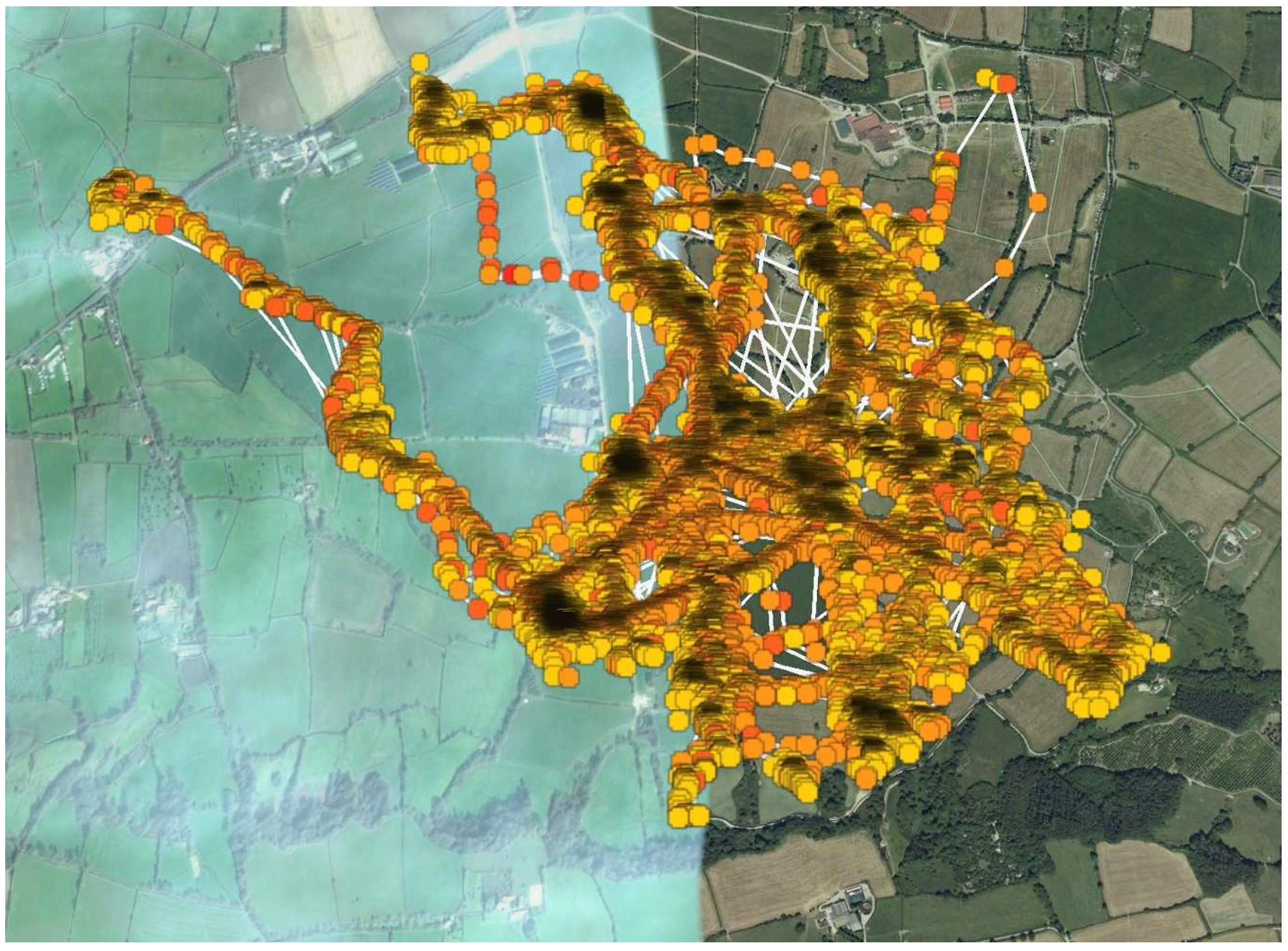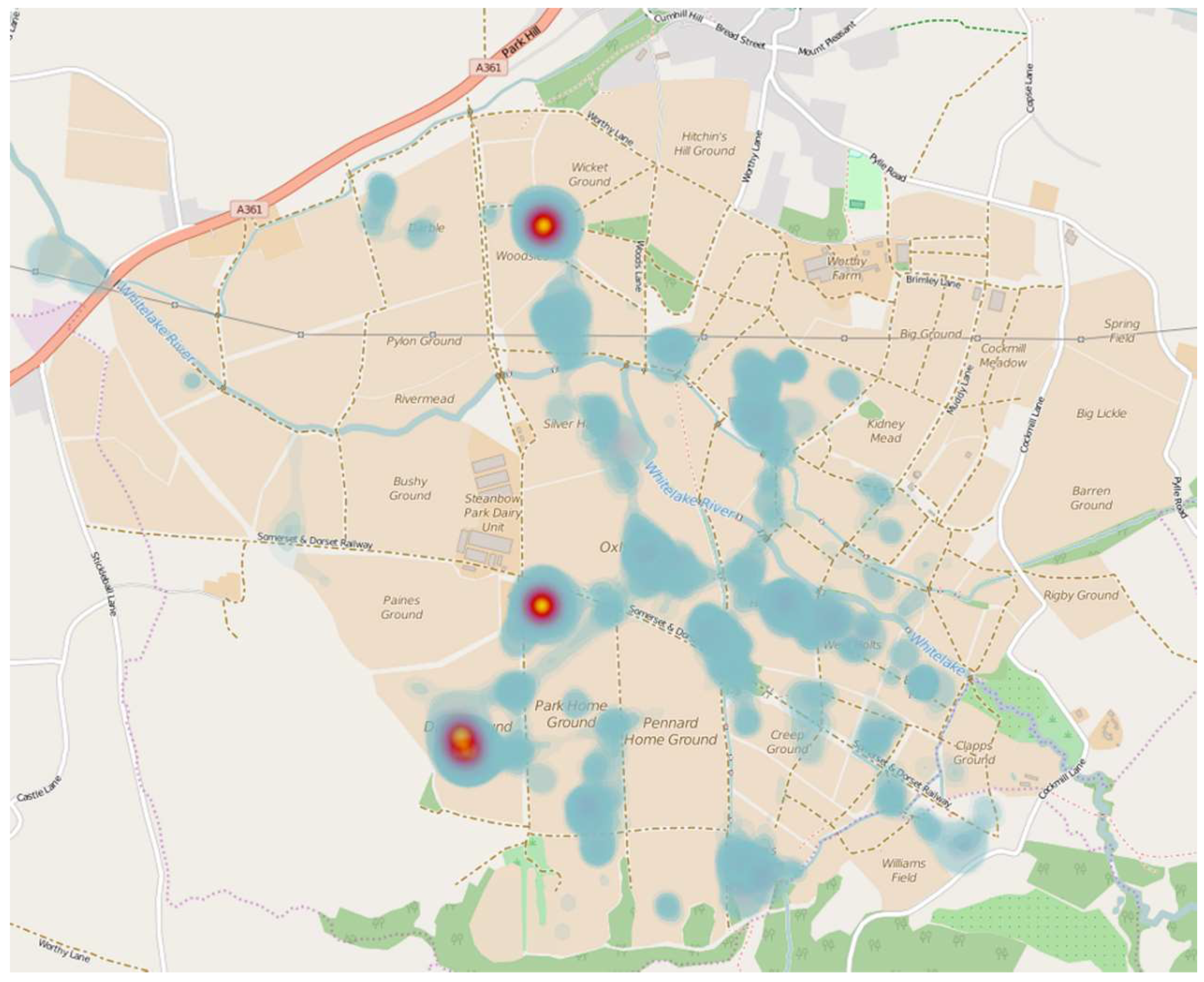Putting the Boom, Boom, Boom into Physical Activity and Health: Music Festivals as a Positive Health Alternative to Couch Fandom
Abstract
1. Introduction
2. Materials and Methods
3. Results
4. Discussion
5. Conclusions
Author Contributions
Funding
Conflicts of Interest
References
- Davis, J.C.; Verhagen, E.; Bryan, S.; Liu-Ambrose, T.; Borland, J.; Buchner, D.; Hendriks, M.R.C.; Weiler, R.; Morrow, J.R., Jr.; van Mechelen, W.; et al. 2014 consensus statement from the first Economics of Physical Inactivity Consensus (EPIC) conference (Vancouver). Br. J. Sports Med. 2014, 48, 947–951. [Google Scholar] [CrossRef]
- Hallal, P.C.; Andersen, L.B.; Bull, F.C.; Guthold, R.; Haskell, W.; Ekelund, U. Global physical activity levels: Surveillance progress, pitfalls, and prospects. Lancet 2012, 380, 247–257. [Google Scholar] [CrossRef]
- Carson, A.P.; Williams, L.B.; Hill, A.N. Physical activity in diabetes: Is any better than none? J. Diabetes Complicat. 2014, 28, 257–258. [Google Scholar] [CrossRef] [PubMed]
- Moody, A. Adult anthropometric measures. In Health Survey for England 2013: Health, Social Care and Lifestyles; Mindell, C.R., Mindell, J., Eds.; Health and Social Care Information Centre: Leeds, UK, 2014; Volume 1, Chapter 10. [Google Scholar]
- National Health Service. Physical Activity Guidelines for Adults. 2015. Available online: http://www.nhs.uk/Livewell/fitness/Pages/physical-activity-guidelines-for-adults.aspx (accessed on 10 May 2015).
- Scholes, S. Health Survey for England 2016: Physical activity in adults. Health and Social Care Information Centre. Available online: https://files.digital.nhs.uk/publication/m/3/hse16-adult-phy-act.pdf (accessed on 12 February 2018).
- Sport England. Active Lives Report May 17/18. Available online: https://www.sportengland.org/media/13563/active-lives-adult-may-17-18-report.pdf (accessed on 30 October 2018).
- Hillsdon, M.; Foster, C.; Thorogood, M. Interventions for promoting physical activity. Cochrane Database Syst. Rev. 2005, 1, CD003180. [Google Scholar]
- Cobiac, L.J.; Vos, T.; Barendregt, J.J. Cost-effectiveness of interventions to promote physical activity: A modelling study. PLoS Med. 2009, 6, e1000110. [Google Scholar] [CrossRef] [PubMed]
- Pillay, J.D.; Kolbe-Alexander, T.L.; Proper, K.I.; van Mechelen, W.; Lambert, E.V. Steps that count! A feasibility study of a pedometer-based, health-promotion intervention in an employed, South African population. S. Afr. J. Sports Med. 2014, 26, 15–19. [Google Scholar] [CrossRef][Green Version]
- Troiano, R.P.; Berrigan, D.; Dodd, K.W.; Mâsse, L.C.; Tilert, T.; McDowell, M. Physical activity in the United States measured by accelerometer. Med. Sci. Sports Exerc. 2008, 40, 181–188. [Google Scholar] [CrossRef]
- Ryan, C.G.; McDonough, S.; Kirwan, J.P.; Leveille, S.; Martin, D.J. An investigation of association between chronic musculoskeletal pain and cardiovascular disease in the Health Survey for England (2008). Eur. J. Pain 2014, 18, 740–750. [Google Scholar] [CrossRef]
- Tudor-Locke, C.; Camhi, S.M.; Troiano, R.P. A catalog of rules, variables, and definitions applied to accelerometer data in the National Health and Nutrition Examination Survey, 2003–2006. Prev. Chronic Dis. 2012, 9, E113. [Google Scholar] [CrossRef]
- Vanhelst, J.; Mikulovic, J.; Bui-Xuan, G.; Dieu, O.; Blondeau, T.; Fardy, P.; Béghin, L. Comparison of two Actigraph accelerometer generations in the assessment of physical activity in free living conditions. BMC Res. Notes 2012, 5, 187. [Google Scholar] [CrossRef]
- Crouter, S.E.; Churilla, J.R.; Bassett, D.R., Jr. Estimating energy expenditure using accelerometers. Eur. J. Appl. Physiol. 2006, 98, 601–612. [Google Scholar] [CrossRef] [PubMed]
- Sasaki, J.E.; Dinesh, J.; Freedson, P.S. Validation and comparison of ActiGraph activity monitors. J. Sci. Med. Sport 2011, 14, 411–416. [Google Scholar] [CrossRef] [PubMed]
- Santos-Lozano, A.; Santín-Medeiros, F.; Cardon, G.; Torres-Luque, G.; Bailón, R.; Bergmeir, C.; Ruiz, J.R.; Lucia, A.; Garatachea, N. Actigraph GT3X: Validation and determination of physical activity intensity cut points. Int. J. Sports Med. 2013, 34, 975–982. [Google Scholar] [CrossRef] [PubMed]
- Kang, B.; Moudon, A.V.; Hurvitz, P.M.; Reichley, L.; Saelens, B.E. Walking objectively measured: Classifying accelerometer data with GPS and travel diaries. Med. Sci. Sports Exerc. 2013, 45, 1419–1428. [Google Scholar] [CrossRef] [PubMed]
- Krenn, P.J.; Titze, S.; Oja, P.; Jones, A.; Ogilvie, D. Use of global positioning systems to study physical activity and the environment. A systematic review. Am. J. Prev. Med. 2011, 41, 508–515. [Google Scholar] [CrossRef]
- Oliver, M.; Badland, H.; Mavoa, S.; Duncan, M.J.; Duncan, S. Combining GPS, GIS, and accelerometry: Methodological issues in the assessment of location and intensity of travel behaviors. J. Phys. Act. Health 2010, 7, 102–108. [Google Scholar] [CrossRef]
- Rodriguez, D.A.; Brown, A.L.; Troped, P.J. Portable global positioning units to complement accelerometry-base physical activity monitors. Med. Sci. Sports Exerc. 2005, 37, S572–S581. [Google Scholar] [CrossRef]
- The Festival Awards Market Report. 2017. Available online: https://www.festivalinsights.com/2017/07/uk-festival-market-report-2017/ (accessed on 31 May 2018).
- Gelder, G.; Robinson, P. A critical comparative study of visitor motivations for attending music festivals: A case study of Glastonbury and V Festival. Event Manag. 2009, 13, 181–196. [Google Scholar] [CrossRef]
- UK Music. Music Tourism: Wish You Were Here. Available online: https://www.ukmusic.org/research/music-tourism-wish-you-were-here-2017/ (accessed on 31 May 2018).
- Glastonbury Festivals. Available online: http://www.glastonburyfestivals.co.uk/information/an-introduction-to-glastonbury-festival/ (accessed on 30 May 2015).
- Bland, J.M.; Altman, D.G. Statistical methods for assessing agreement between two methods of clinical measurement. Lancet 1986, 1, 307–310. [Google Scholar] [CrossRef]
- Jennings, D.; Cormack, S.; Coutts, A.J.; Boyd, L.; Aughey, R.J. The validity and reliability of GPS units for measuring distance in team sport specific running patterns. Int. J. Sports Physiol. Perform. 2010, 5, 328–341. [Google Scholar] [CrossRef]
- Cho, G.H.; Rodriguez, D.A.; Evenson, K.R. Identifying walking trips using GPS data. Med. Sci. Sports Exerc. 2011, 43, 365. [Google Scholar] [CrossRef] [PubMed]
- Tudor-Locke, C.; Bassett, D.R., Jr. How many steps/day are enough? Preliminary pedometer indices for public health. Sports Med. 2004, 34, 1–8. [Google Scholar] [CrossRef]
- Bakrani, K.; Edwardson, C.L.; Bodicot, D.H.; Esliger, D.W.; Gill, J.M.R.; Kazi, A.; Velayudhan, L.; Sinclair, A.J.; Sattar, N.; Biddle, S.J.H.; et al. Associations of mutually exclusive categories of physical activity and sedentary time with markers of cardiometabolic health in English adults: A cross-sectional analysis of the Health Survey for England. BMC Public Health 2016, 16, 25. [Google Scholar] [CrossRef] [PubMed]
- Glanz, K.; Rimer, B.K.; Viswanath, K. Health Behaviour and Health Education—Theory, Research and Practice, 4th ed.; John Wiley and Sons: San Francisco, CA, USA, 2008. [Google Scholar]
- Boulton, E.R.; Horne, M.; Todd, C. Multiple influences on participating in physical activity in older age: Developing a social ecological approach. Health Expect. 2018, 21, 239–248. [Google Scholar] [CrossRef] [PubMed]
- Harrington, D.M.; Welk, G.J.; Donnelly, A.E. Validation of MET estimates and step measurement using the ActivPAL physical activity logger. J. Sports Sci. 2011, 29, 627–633. [Google Scholar] [CrossRef] [PubMed]
- Fong Yan, A.; Cobley, S.; Chan, C.; Pappas, E.; Nicholson, L.L.; Ward, R.E.; Murdoch, R.E.; Gu, Y.; Trevor, B.L.; Vassallo, A.J.; et al. The effectiveness of dance interventions on physical health outcomes compared to other forms of physical activity: A systematic review and meta-analysis. Sports Med. 2018, 48, 933–951. [Google Scholar] [CrossRef]
- Murrock, C.J.; Graor, C.H. Effects of dance on depression, physical function, and disability in underserved adults. J. Aging Phys. Act. 2014, 22, 380–385. [Google Scholar] [CrossRef] [PubMed]
- Schroeder, K.; Ratcliffe, S.J.; Perez, A.; Earley, D.; Bowman, C.; Lipman, T.H. Dance for Health: An intergenerational program to increase access to physical activity. J. Pediatr. Nurs. 2017, 37, 29–34. [Google Scholar] [CrossRef] [PubMed]
- Paz-Soldan, V.A.; Reiner, R.C., Jr.; Morrison, A.C.; Stoddard, S.T.; Kitron, U.; Scott, T.W.; Elder, J.P.; Halsey, E.S.; Kochel, T.J.; Astete, H.; et al. Strengths and weaknesses of Global Positioning System (GPS) data-loggers and semi-structured interviews for capturing fine-scale human mobility: Findings from Iquitos, Peru. PLoS Negl. Trop. Dis. 2014, 8, e2888. [Google Scholar] [CrossRef]
- Ancliffe, S. Crowd planning for public safety. Perspect. Public Health 2017, 137, 25–28. [Google Scholar]


| Characteristic | Mean (±SD); Range |
|---|---|
| Age (years) | 32 ± 8; 22–57 |
| Height (cm) | 179.09 ± 4.92; 169–186 |
| Weight (kg) | 81.32 ± 21.51; 58–152 |
| Attendance (number of times) | 5 ± 2; 1–10 |
| Sedentary | Light | Moderate | Vigorous | Total Time in MVPA * | |
|---|---|---|---|---|---|
| Wednesday | 281 ± 198; 38–735 | 565 ± 180; 263–919 | 118 ± 70; 2–232 | 16 ± 15; 0–48 | 134 ± 76; 3–262 |
| Thursday | 708 ± 205; 394–1093 | 564 ± 197; 202–935 | 143 ± 43; 86–239 | 25 ± 24; 1–94 | 168 ± 50; 87–246 |
| Friday | 746 ± 177; 485–1036 | 531 ± 177; 227–821 | 142 ± 44; 65–221 | 22 ± 33; 0–141 | 163 ± 53; 67–272 |
| Saturday | 817 ± 216; 431–1372 | 420 ± 214; 44–863 | 183 ± 61; 24–279 | 20 ± 23; 0–79 | 203 ± 72; 24–344 |
| Sunday | 729 ± 190; 376–1058 | 519 ± 201; 238–900 | 173 ± 64; 68–291 | 19 ± 18; 0–53 | 192 ± 75;77–344 |
| Monday | 393 ± 194; 87–810 | 398 ± 171; 151–701 | 60 ± 31; 3–124 | 8 ± 9; 1–24 | 68 ± 32; 3–126 |
| Total | 3673 ± 789; 2287–5369 | 2997 ± 761; 1619–4716 | 819 ± 208; 468–1190 | 109 ± 85; 5–262 | 927 ± 252; 473–1389 |
| Mean | 612 ± 132; 381–895 | 500 ± 127; 270–786 | 136 ± 35; 78–198 | 18 ± 14; 1–44 | 155 ± 42; 79–231 |
| Distance (km) | Movement Time (hr:mm:ss) | Average Moving Speed (km/h) | Step Count | |
|---|---|---|---|---|
| Wednesday | 9.25 ± 4.66; 0.52–15.90 | 7:04:00 ± 2:24:23; 2:01:32–11:31:51 | 1.00 ± 0.49; 0.10–1.90 | 14,427 ± 5185; 3511–25,398 |
| Thursday | 12.63 ± 2.63; 8.75–17.38 | 13:22:30 ± 3:21:20; 2:38:22–16:56:06 | 0.84 ± 0.50; 0.40–2.70 | 16,406 ± 4269; 11,086–24,145 |
| Friday | 11.65 ± 2.49; 7.02–17.58 | 14:44:00 ± 2:56:08; 10:25:53–20:03:45 | 0.66 ± 0.24; 0.30–1.35 | 16,030 ± 3116; 11,445–21,574 |
| Saturday | 13.82 ± 3.65; 2.61–19.95 | 14:50:15 ± 3:06:55; 9:35:12–20:02:35 | 0.74 ± 0.28; 0.20–1.30 | 19,682 ± 5809; 2365–30,832 |
| Sunday | 13.50 ± 4.65; 5.07–20.67 | 13:22:13 ± 3:15:44; 5:33:07–17:35:32 | 0.86 ± 0.57; 0.30–2.85 | 20,013 ± 5938; 8793–28,989 |
| Monday | 5.22 ± 2.28; 2.16–11.18 | 5:25:24 ± 1:45:44; 2:22:14–8:29:21 | 0.72 ± 0.30; 0.20–1.40 | 7407 ± 3735; 1630–15,540 |
| Total | 66.08 ± 11.34; 47.03–84.51 | 68:48:22 ± 10:44:44; 40:59:44–86:38:05 | 93,966 ± 18,284; 73,543–135,817 | |
| Daily Mean | 11.01 ± 1.89; 7.84–14.09 | 11:28:04 ± 1:47:27; 6:49:57–14:26:21 | 0.80 ± 0.28; 0.40–1.63 | 15,661 ± 3047; 11,257–22,636 |
© 2019 by the authors. Licensee MDPI, Basel, Switzerland. This article is an open access article distributed under the terms and conditions of the Creative Commons Attribution (CC BY) license (http://creativecommons.org/licenses/by/4.0/).
Share and Cite
Bradley, E.; Close, L.; Whyte, I. Putting the Boom, Boom, Boom into Physical Activity and Health: Music Festivals as a Positive Health Alternative to Couch Fandom. Int. J. Environ. Res. Public Health 2019, 16, 2105. https://doi.org/10.3390/ijerph16122105
Bradley E, Close L, Whyte I. Putting the Boom, Boom, Boom into Physical Activity and Health: Music Festivals as a Positive Health Alternative to Couch Fandom. International Journal of Environmental Research and Public Health. 2019; 16(12):2105. https://doi.org/10.3390/ijerph16122105
Chicago/Turabian StyleBradley, Eddie, Lauren Close, and Ian Whyte. 2019. "Putting the Boom, Boom, Boom into Physical Activity and Health: Music Festivals as a Positive Health Alternative to Couch Fandom" International Journal of Environmental Research and Public Health 16, no. 12: 2105. https://doi.org/10.3390/ijerph16122105
APA StyleBradley, E., Close, L., & Whyte, I. (2019). Putting the Boom, Boom, Boom into Physical Activity and Health: Music Festivals as a Positive Health Alternative to Couch Fandom. International Journal of Environmental Research and Public Health, 16(12), 2105. https://doi.org/10.3390/ijerph16122105





